Review of Personal Health Record Systems: Implementation, Challenges
VerifiedAdded on 2023/06/12
|8
|2011
|303
Report
AI Summary
This report provides a detailed analysis of Personal Health Record (PHR) systems, comparing their use in different healthcare systems within the U.S.A, specifically highlighting Standalone and Connected PHRs. It explores the challenges in implementing PHR systems, including security concerns, privacy issues, costs, and the varying levels of health literacy among users. The report also considers the opinions of key stakeholders such as physicians, employers, and consumers, noting physician apprehensions regarding data accuracy and increased workload. A personal reflection on the 'My Health Record' system in Australia illustrates the practical benefits of PHRs in improving patient care and information access. The report concludes by emphasizing the importance of PHRs in transforming the healthcare system and controlling costs, while acknowledging the need to address existing challenges to ensure their effective and widespread adoption.
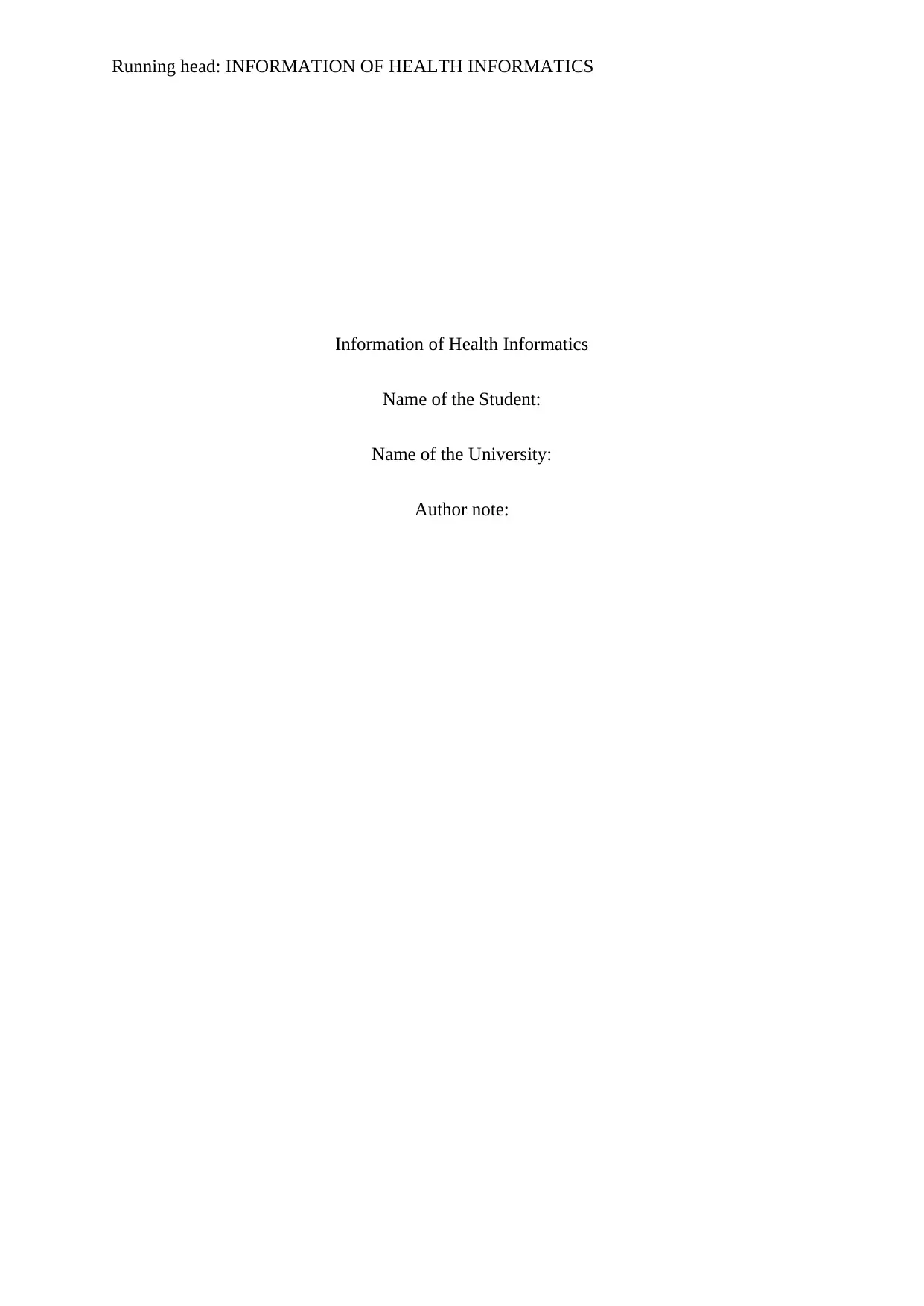
Running head: INFORMATION OF HEALTH INFORMATICS
Information of Health Informatics
Name of the Student:
Name of the University:
Author note:
Information of Health Informatics
Name of the Student:
Name of the University:
Author note:
Paraphrase This Document
Need a fresh take? Get an instant paraphrase of this document with our AI Paraphraser
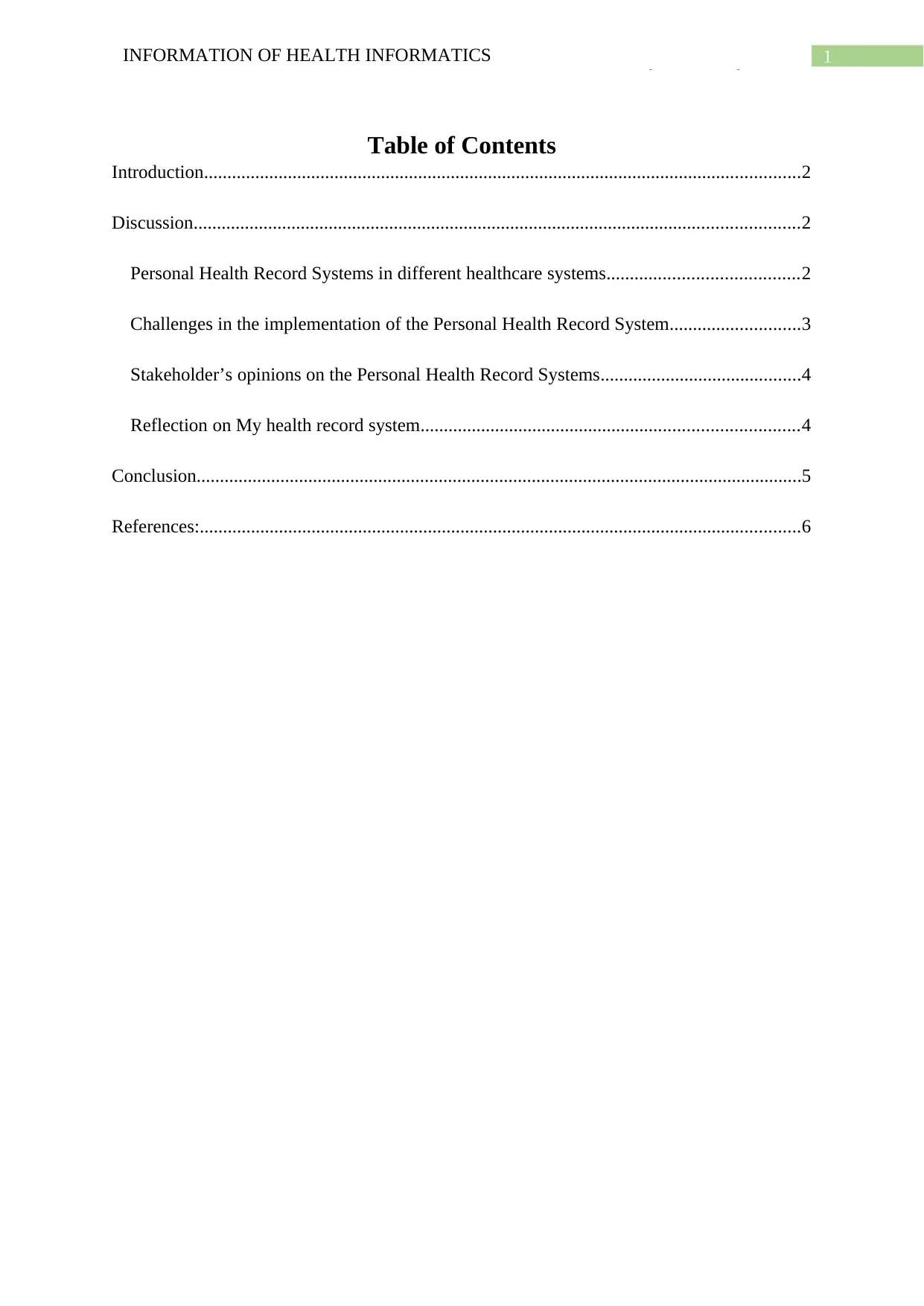
1INFORMATION OF HEALTH INFORMATICS
References:References:
Table of Contents
Introduction................................................................................................................................2
Discussion..................................................................................................................................2
Personal Health Record Systems in different healthcare systems.........................................2
Challenges in the implementation of the Personal Health Record System............................3
Stakeholder’s opinions on the Personal Health Record Systems...........................................4
Reflection on My health record system.................................................................................4
Conclusion..................................................................................................................................5
References:.................................................................................................................................6
References:References:
Table of Contents
Introduction................................................................................................................................2
Discussion..................................................................................................................................2
Personal Health Record Systems in different healthcare systems.........................................2
Challenges in the implementation of the Personal Health Record System............................3
Stakeholder’s opinions on the Personal Health Record Systems...........................................4
Reflection on My health record system.................................................................................4
Conclusion..................................................................................................................................5
References:.................................................................................................................................6
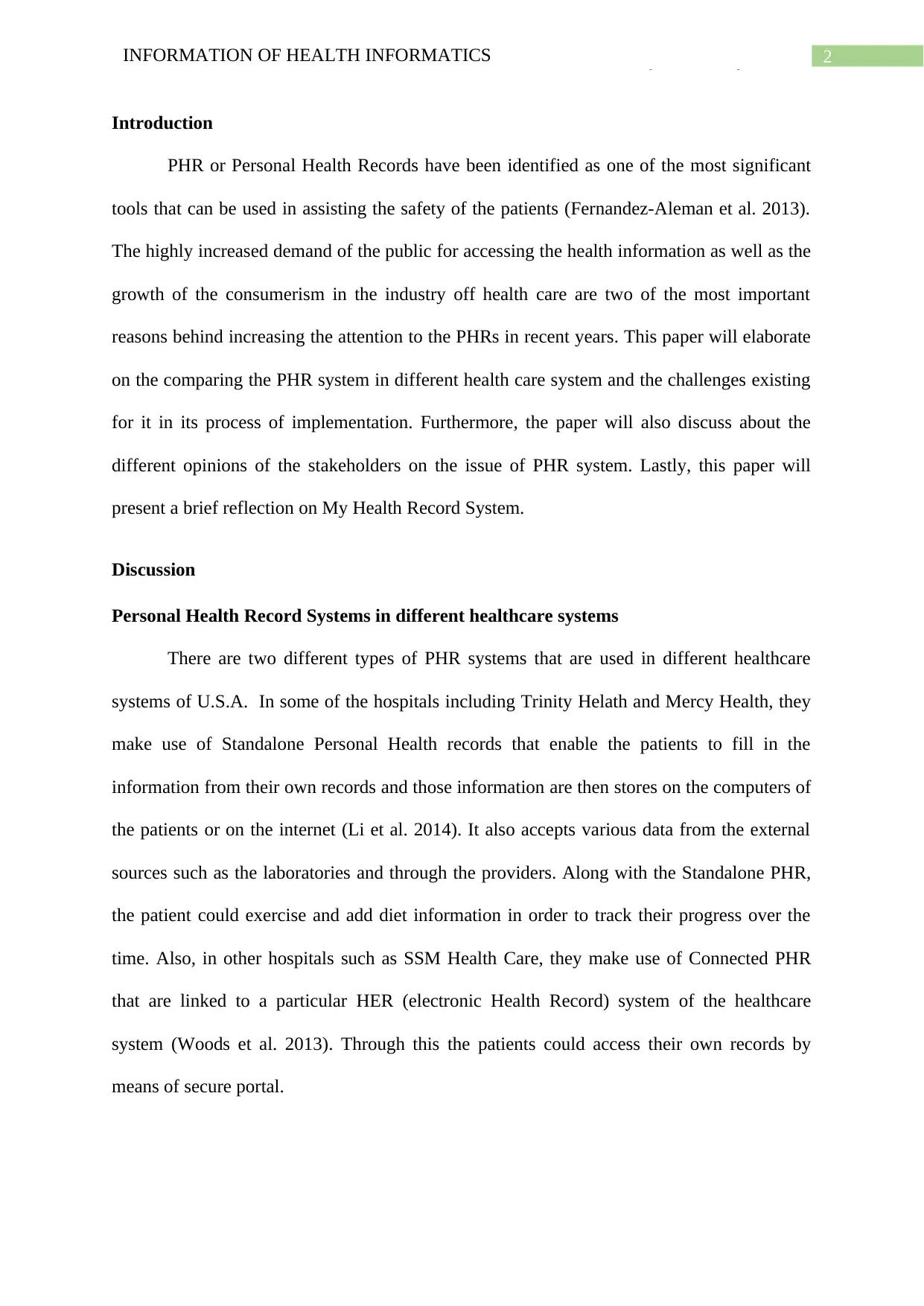
2INFORMATION OF HEALTH INFORMATICS
References:References:
Introduction
PHR or Personal Health Records have been identified as one of the most significant
tools that can be used in assisting the safety of the patients (Fernandez-Aleman et al. 2013).
The highly increased demand of the public for accessing the health information as well as the
growth of the consumerism in the industry off health care are two of the most important
reasons behind increasing the attention to the PHRs in recent years. This paper will elaborate
on the comparing the PHR system in different health care system and the challenges existing
for it in its process of implementation. Furthermore, the paper will also discuss about the
different opinions of the stakeholders on the issue of PHR system. Lastly, this paper will
present a brief reflection on My Health Record System.
Discussion
Personal Health Record Systems in different healthcare systems
There are two different types of PHR systems that are used in different healthcare
systems of U.S.A. In some of the hospitals including Trinity Helath and Mercy Health, they
make use of Standalone Personal Health records that enable the patients to fill in the
information from their own records and those information are then stores on the computers of
the patients or on the internet (Li et al. 2014). It also accepts various data from the external
sources such as the laboratories and through the providers. Along with the Standalone PHR,
the patient could exercise and add diet information in order to track their progress over the
time. Also, in other hospitals such as SSM Health Care, they make use of Connected PHR
that are linked to a particular HER (electronic Health Record) system of the healthcare
system (Woods et al. 2013). Through this the patients could access their own records by
means of secure portal.
References:References:
Introduction
PHR or Personal Health Records have been identified as one of the most significant
tools that can be used in assisting the safety of the patients (Fernandez-Aleman et al. 2013).
The highly increased demand of the public for accessing the health information as well as the
growth of the consumerism in the industry off health care are two of the most important
reasons behind increasing the attention to the PHRs in recent years. This paper will elaborate
on the comparing the PHR system in different health care system and the challenges existing
for it in its process of implementation. Furthermore, the paper will also discuss about the
different opinions of the stakeholders on the issue of PHR system. Lastly, this paper will
present a brief reflection on My Health Record System.
Discussion
Personal Health Record Systems in different healthcare systems
There are two different types of PHR systems that are used in different healthcare
systems of U.S.A. In some of the hospitals including Trinity Helath and Mercy Health, they
make use of Standalone Personal Health records that enable the patients to fill in the
information from their own records and those information are then stores on the computers of
the patients or on the internet (Li et al. 2014). It also accepts various data from the external
sources such as the laboratories and through the providers. Along with the Standalone PHR,
the patient could exercise and add diet information in order to track their progress over the
time. Also, in other hospitals such as SSM Health Care, they make use of Connected PHR
that are linked to a particular HER (electronic Health Record) system of the healthcare
system (Woods et al. 2013). Through this the patients could access their own records by
means of secure portal.
⊘ This is a preview!⊘
Do you want full access?
Subscribe today to unlock all pages.

Trusted by 1+ million students worldwide
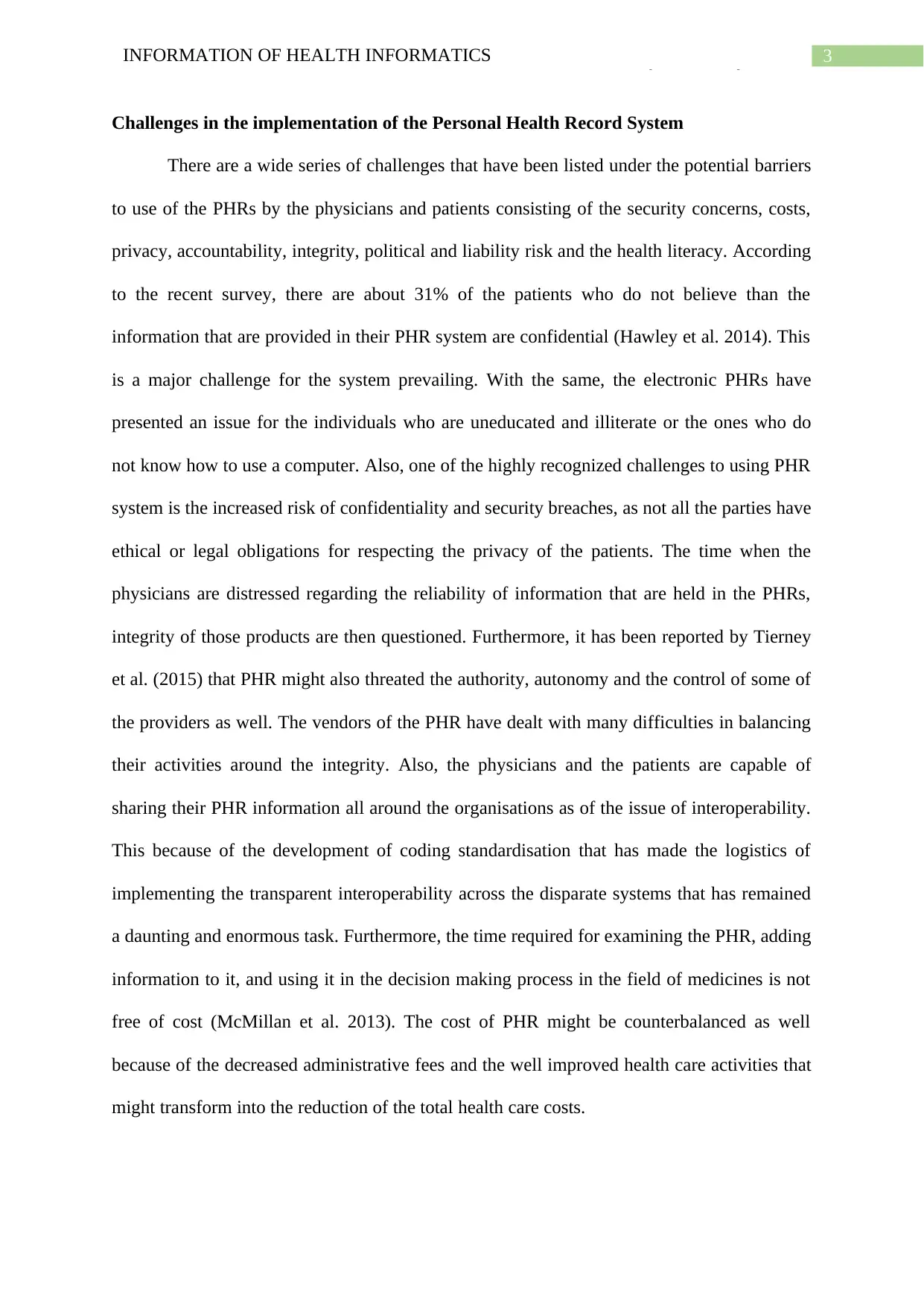
3INFORMATION OF HEALTH INFORMATICS
References:References:
Challenges in the implementation of the Personal Health Record System
There are a wide series of challenges that have been listed under the potential barriers
to use of the PHRs by the physicians and patients consisting of the security concerns, costs,
privacy, accountability, integrity, political and liability risk and the health literacy. According
to the recent survey, there are about 31% of the patients who do not believe than the
information that are provided in their PHR system are confidential (Hawley et al. 2014). This
is a major challenge for the system prevailing. With the same, the electronic PHRs have
presented an issue for the individuals who are uneducated and illiterate or the ones who do
not know how to use a computer. Also, one of the highly recognized challenges to using PHR
system is the increased risk of confidentiality and security breaches, as not all the parties have
ethical or legal obligations for respecting the privacy of the patients. The time when the
physicians are distressed regarding the reliability of information that are held in the PHRs,
integrity of those products are then questioned. Furthermore, it has been reported by Tierney
et al. (2015) that PHR might also threated the authority, autonomy and the control of some of
the providers as well. The vendors of the PHR have dealt with many difficulties in balancing
their activities around the integrity. Also, the physicians and the patients are capable of
sharing their PHR information all around the organisations as of the issue of interoperability.
This because of the development of coding standardisation that has made the logistics of
implementing the transparent interoperability across the disparate systems that has remained
a daunting and enormous task. Furthermore, the time required for examining the PHR, adding
information to it, and using it in the decision making process in the field of medicines is not
free of cost (McMillan et al. 2013). The cost of PHR might be counterbalanced as well
because of the decreased administrative fees and the well improved health care activities that
might transform into the reduction of the total health care costs.
References:References:
Challenges in the implementation of the Personal Health Record System
There are a wide series of challenges that have been listed under the potential barriers
to use of the PHRs by the physicians and patients consisting of the security concerns, costs,
privacy, accountability, integrity, political and liability risk and the health literacy. According
to the recent survey, there are about 31% of the patients who do not believe than the
information that are provided in their PHR system are confidential (Hawley et al. 2014). This
is a major challenge for the system prevailing. With the same, the electronic PHRs have
presented an issue for the individuals who are uneducated and illiterate or the ones who do
not know how to use a computer. Also, one of the highly recognized challenges to using PHR
system is the increased risk of confidentiality and security breaches, as not all the parties have
ethical or legal obligations for respecting the privacy of the patients. The time when the
physicians are distressed regarding the reliability of information that are held in the PHRs,
integrity of those products are then questioned. Furthermore, it has been reported by Tierney
et al. (2015) that PHR might also threated the authority, autonomy and the control of some of
the providers as well. The vendors of the PHR have dealt with many difficulties in balancing
their activities around the integrity. Also, the physicians and the patients are capable of
sharing their PHR information all around the organisations as of the issue of interoperability.
This because of the development of coding standardisation that has made the logistics of
implementing the transparent interoperability across the disparate systems that has remained
a daunting and enormous task. Furthermore, the time required for examining the PHR, adding
information to it, and using it in the decision making process in the field of medicines is not
free of cost (McMillan et al. 2013). The cost of PHR might be counterbalanced as well
because of the decreased administrative fees and the well improved health care activities that
might transform into the reduction of the total health care costs.
Paraphrase This Document
Need a fresh take? Get an instant paraphrase of this document with our AI Paraphraser
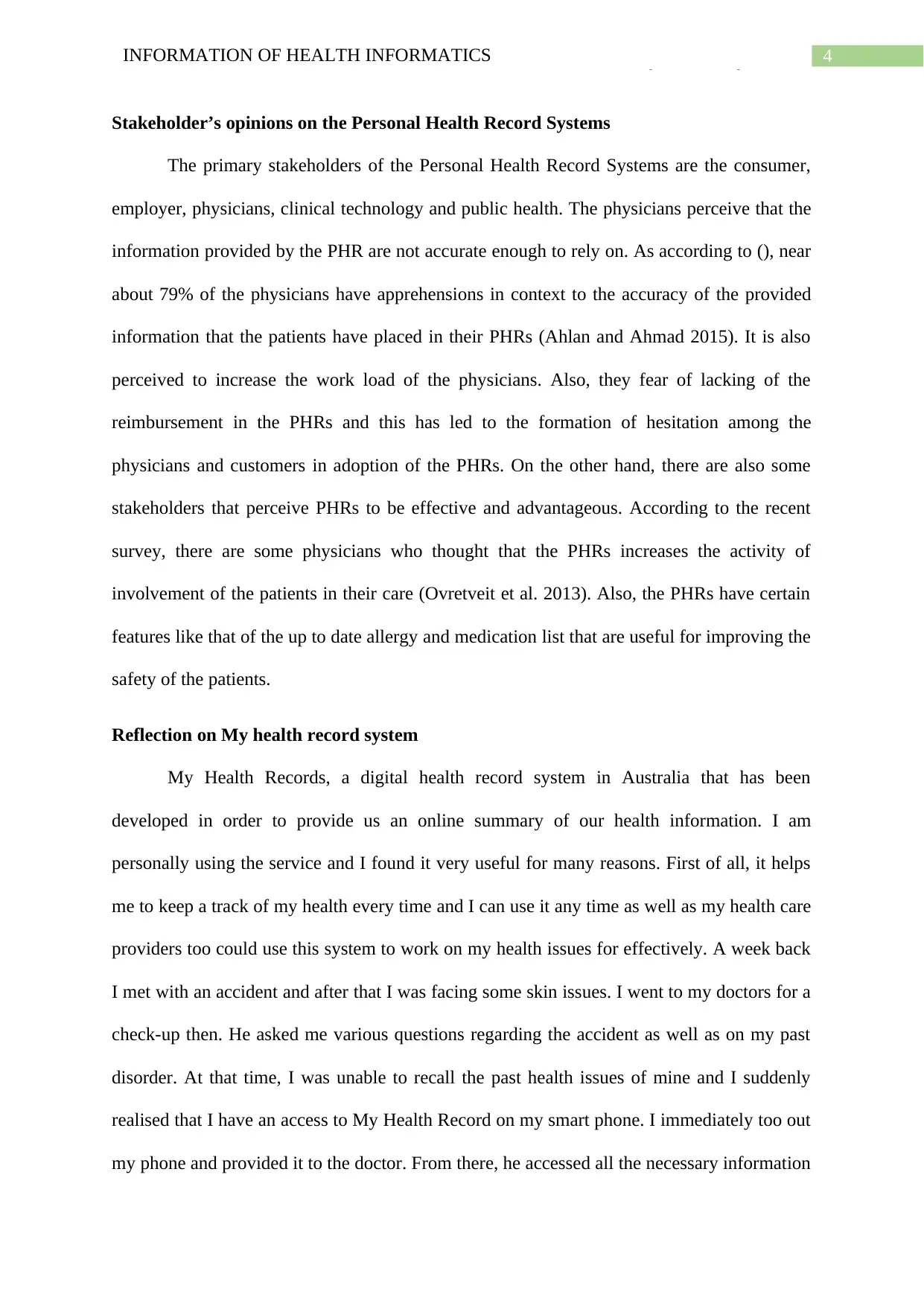
4INFORMATION OF HEALTH INFORMATICS
References:References:
Stakeholder’s opinions on the Personal Health Record Systems
The primary stakeholders of the Personal Health Record Systems are the consumer,
employer, physicians, clinical technology and public health. The physicians perceive that the
information provided by the PHR are not accurate enough to rely on. As according to (), near
about 79% of the physicians have apprehensions in context to the accuracy of the provided
information that the patients have placed in their PHRs (Ahlan and Ahmad 2015). It is also
perceived to increase the work load of the physicians. Also, they fear of lacking of the
reimbursement in the PHRs and this has led to the formation of hesitation among the
physicians and customers in adoption of the PHRs. On the other hand, there are also some
stakeholders that perceive PHRs to be effective and advantageous. According to the recent
survey, there are some physicians who thought that the PHRs increases the activity of
involvement of the patients in their care (Ovretveit et al. 2013). Also, the PHRs have certain
features like that of the up to date allergy and medication list that are useful for improving the
safety of the patients.
Reflection on My health record system
My Health Records, a digital health record system in Australia that has been
developed in order to provide us an online summary of our health information. I am
personally using the service and I found it very useful for many reasons. First of all, it helps
me to keep a track of my health every time and I can use it any time as well as my health care
providers too could use this system to work on my health issues for effectively. A week back
I met with an accident and after that I was facing some skin issues. I went to my doctors for a
check-up then. He asked me various questions regarding the accident as well as on my past
disorder. At that time, I was unable to recall the past health issues of mine and I suddenly
realised that I have an access to My Health Record on my smart phone. I immediately too out
my phone and provided it to the doctor. From there, he accessed all the necessary information
References:References:
Stakeholder’s opinions on the Personal Health Record Systems
The primary stakeholders of the Personal Health Record Systems are the consumer,
employer, physicians, clinical technology and public health. The physicians perceive that the
information provided by the PHR are not accurate enough to rely on. As according to (), near
about 79% of the physicians have apprehensions in context to the accuracy of the provided
information that the patients have placed in their PHRs (Ahlan and Ahmad 2015). It is also
perceived to increase the work load of the physicians. Also, they fear of lacking of the
reimbursement in the PHRs and this has led to the formation of hesitation among the
physicians and customers in adoption of the PHRs. On the other hand, there are also some
stakeholders that perceive PHRs to be effective and advantageous. According to the recent
survey, there are some physicians who thought that the PHRs increases the activity of
involvement of the patients in their care (Ovretveit et al. 2013). Also, the PHRs have certain
features like that of the up to date allergy and medication list that are useful for improving the
safety of the patients.
Reflection on My health record system
My Health Records, a digital health record system in Australia that has been
developed in order to provide us an online summary of our health information. I am
personally using the service and I found it very useful for many reasons. First of all, it helps
me to keep a track of my health every time and I can use it any time as well as my health care
providers too could use this system to work on my health issues for effectively. A week back
I met with an accident and after that I was facing some skin issues. I went to my doctors for a
check-up then. He asked me various questions regarding the accident as well as on my past
disorder. At that time, I was unable to recall the past health issues of mine and I suddenly
realised that I have an access to My Health Record on my smart phone. I immediately too out
my phone and provided it to the doctor. From there, he accessed all the necessary information
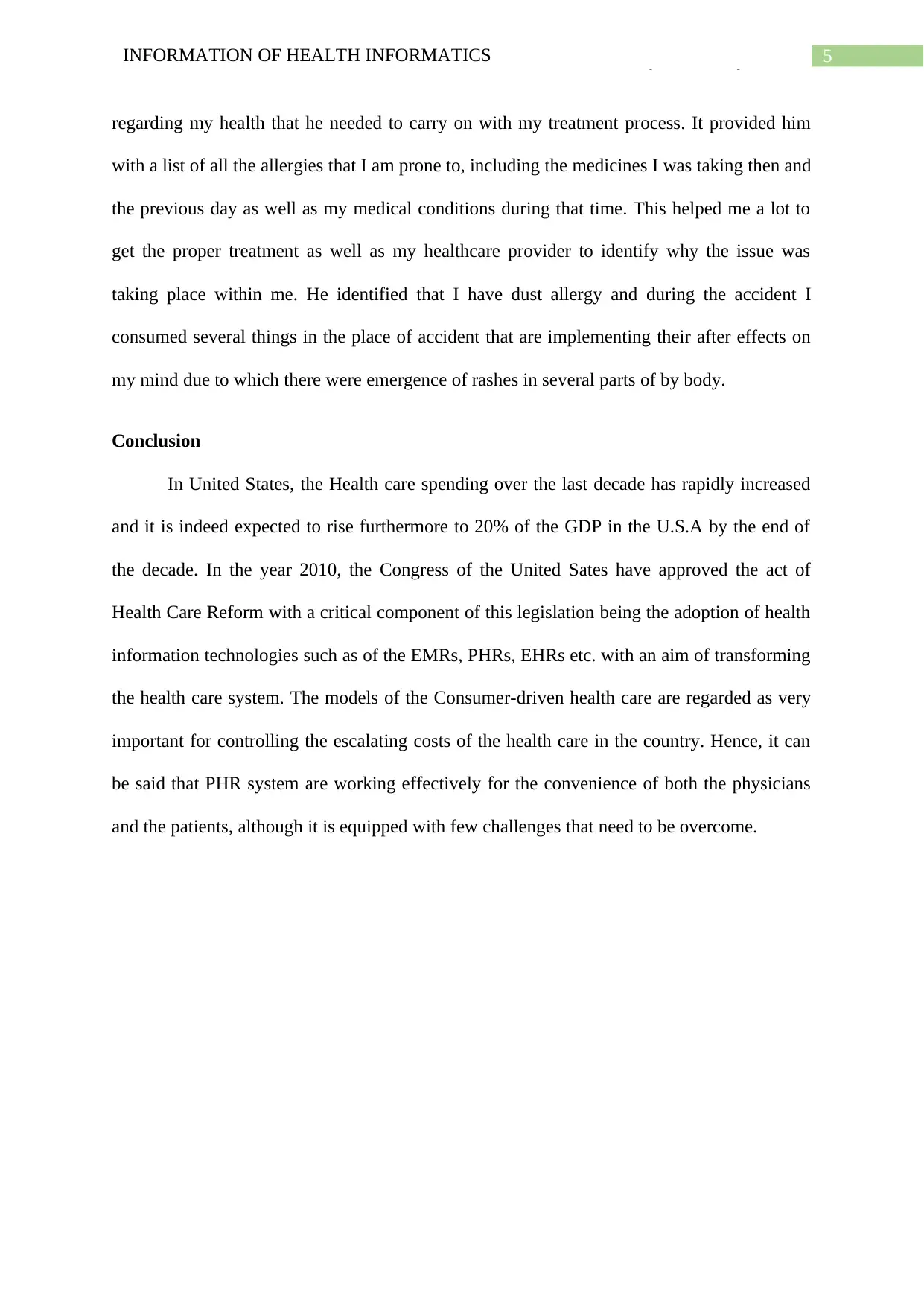
5INFORMATION OF HEALTH INFORMATICS
References:References:
regarding my health that he needed to carry on with my treatment process. It provided him
with a list of all the allergies that I am prone to, including the medicines I was taking then and
the previous day as well as my medical conditions during that time. This helped me a lot to
get the proper treatment as well as my healthcare provider to identify why the issue was
taking place within me. He identified that I have dust allergy and during the accident I
consumed several things in the place of accident that are implementing their after effects on
my mind due to which there were emergence of rashes in several parts of by body.
Conclusion
In United States, the Health care spending over the last decade has rapidly increased
and it is indeed expected to rise furthermore to 20% of the GDP in the U.S.A by the end of
the decade. In the year 2010, the Congress of the United Sates have approved the act of
Health Care Reform with a critical component of this legislation being the adoption of health
information technologies such as of the EMRs, PHRs, EHRs etc. with an aim of transforming
the health care system. The models of the Consumer-driven health care are regarded as very
important for controlling the escalating costs of the health care in the country. Hence, it can
be said that PHR system are working effectively for the convenience of both the physicians
and the patients, although it is equipped with few challenges that need to be overcome.
References:References:
regarding my health that he needed to carry on with my treatment process. It provided him
with a list of all the allergies that I am prone to, including the medicines I was taking then and
the previous day as well as my medical conditions during that time. This helped me a lot to
get the proper treatment as well as my healthcare provider to identify why the issue was
taking place within me. He identified that I have dust allergy and during the accident I
consumed several things in the place of accident that are implementing their after effects on
my mind due to which there were emergence of rashes in several parts of by body.
Conclusion
In United States, the Health care spending over the last decade has rapidly increased
and it is indeed expected to rise furthermore to 20% of the GDP in the U.S.A by the end of
the decade. In the year 2010, the Congress of the United Sates have approved the act of
Health Care Reform with a critical component of this legislation being the adoption of health
information technologies such as of the EMRs, PHRs, EHRs etc. with an aim of transforming
the health care system. The models of the Consumer-driven health care are regarded as very
important for controlling the escalating costs of the health care in the country. Hence, it can
be said that PHR system are working effectively for the convenience of both the physicians
and the patients, although it is equipped with few challenges that need to be overcome.
⊘ This is a preview!⊘
Do you want full access?
Subscribe today to unlock all pages.

Trusted by 1+ million students worldwide
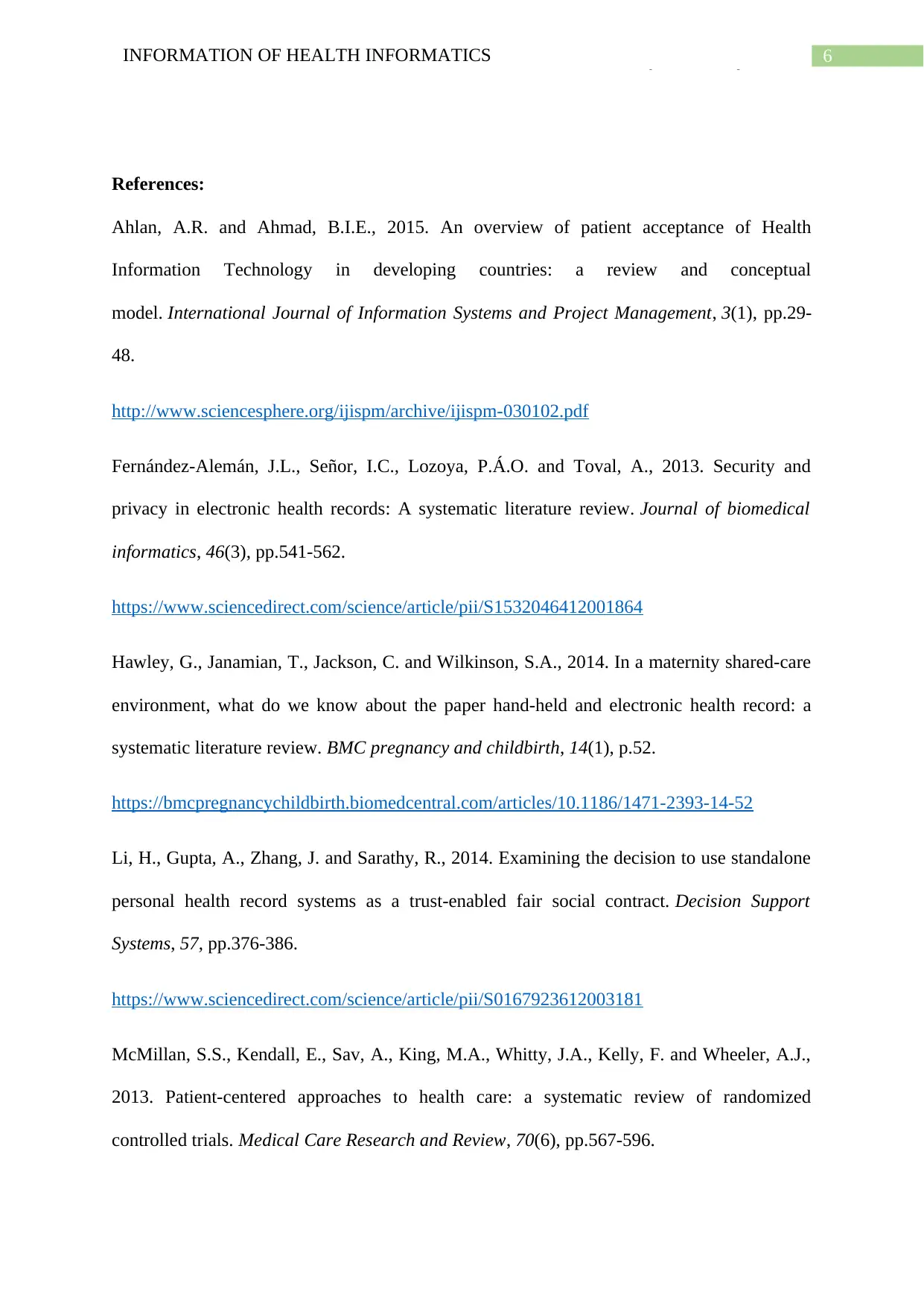
6INFORMATION OF HEALTH INFORMATICS
References:References:
References:
Ahlan, A.R. and Ahmad, B.I.E., 2015. An overview of patient acceptance of Health
Information Technology in developing countries: a review and conceptual
model. International Journal of Information Systems and Project Management, 3(1), pp.29-
48.
http://www.sciencesphere.org/ijispm/archive/ijispm-030102.pdf
Fernández-Alemán, J.L., Señor, I.C., Lozoya, P.Á.O. and Toval, A., 2013. Security and
privacy in electronic health records: A systematic literature review. Journal of biomedical
informatics, 46(3), pp.541-562.
https://www.sciencedirect.com/science/article/pii/S1532046412001864
Hawley, G., Janamian, T., Jackson, C. and Wilkinson, S.A., 2014. In a maternity shared-care
environment, what do we know about the paper hand-held and electronic health record: a
systematic literature review. BMC pregnancy and childbirth, 14(1), p.52.
https://bmcpregnancychildbirth.biomedcentral.com/articles/10.1186/1471-2393-14-52
Li, H., Gupta, A., Zhang, J. and Sarathy, R., 2014. Examining the decision to use standalone
personal health record systems as a trust-enabled fair social contract. Decision Support
Systems, 57, pp.376-386.
https://www.sciencedirect.com/science/article/pii/S0167923612003181
McMillan, S.S., Kendall, E., Sav, A., King, M.A., Whitty, J.A., Kelly, F. and Wheeler, A.J.,
2013. Patient-centered approaches to health care: a systematic review of randomized
controlled trials. Medical Care Research and Review, 70(6), pp.567-596.
References:References:
References:
Ahlan, A.R. and Ahmad, B.I.E., 2015. An overview of patient acceptance of Health
Information Technology in developing countries: a review and conceptual
model. International Journal of Information Systems and Project Management, 3(1), pp.29-
48.
http://www.sciencesphere.org/ijispm/archive/ijispm-030102.pdf
Fernández-Alemán, J.L., Señor, I.C., Lozoya, P.Á.O. and Toval, A., 2013. Security and
privacy in electronic health records: A systematic literature review. Journal of biomedical
informatics, 46(3), pp.541-562.
https://www.sciencedirect.com/science/article/pii/S1532046412001864
Hawley, G., Janamian, T., Jackson, C. and Wilkinson, S.A., 2014. In a maternity shared-care
environment, what do we know about the paper hand-held and electronic health record: a
systematic literature review. BMC pregnancy and childbirth, 14(1), p.52.
https://bmcpregnancychildbirth.biomedcentral.com/articles/10.1186/1471-2393-14-52
Li, H., Gupta, A., Zhang, J. and Sarathy, R., 2014. Examining the decision to use standalone
personal health record systems as a trust-enabled fair social contract. Decision Support
Systems, 57, pp.376-386.
https://www.sciencedirect.com/science/article/pii/S0167923612003181
McMillan, S.S., Kendall, E., Sav, A., King, M.A., Whitty, J.A., Kelly, F. and Wheeler, A.J.,
2013. Patient-centered approaches to health care: a systematic review of randomized
controlled trials. Medical Care Research and Review, 70(6), pp.567-596.
Paraphrase This Document
Need a fresh take? Get an instant paraphrase of this document with our AI Paraphraser
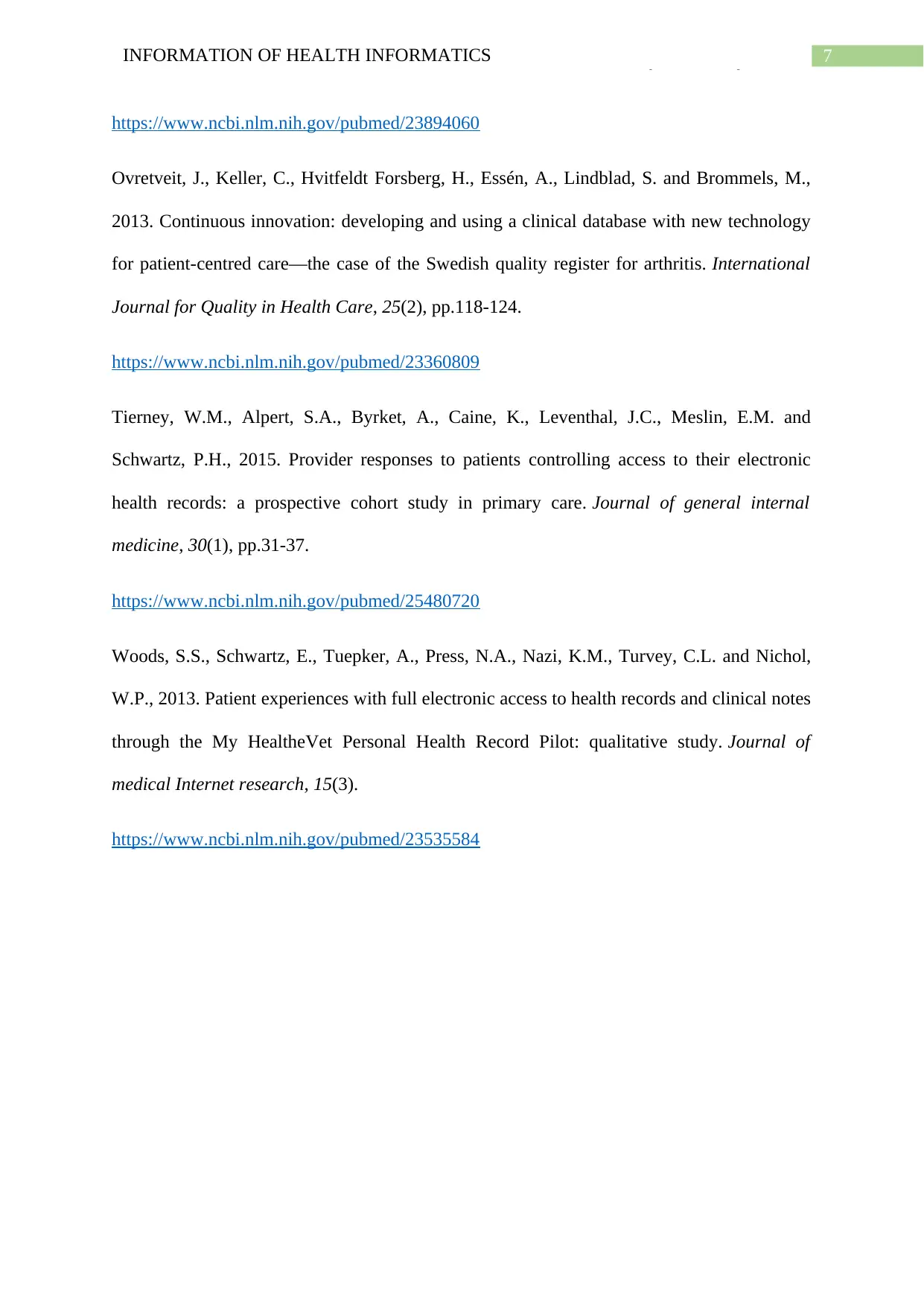
7INFORMATION OF HEALTH INFORMATICS
References:References:
https://www.ncbi.nlm.nih.gov/pubmed/23894060
Ovretveit, J., Keller, C., Hvitfeldt Forsberg, H., Essén, A., Lindblad, S. and Brommels, M.,
2013. Continuous innovation: developing and using a clinical database with new technology
for patient-centred care—the case of the Swedish quality register for arthritis. International
Journal for Quality in Health Care, 25(2), pp.118-124.
https://www.ncbi.nlm.nih.gov/pubmed/23360809
Tierney, W.M., Alpert, S.A., Byrket, A., Caine, K., Leventhal, J.C., Meslin, E.M. and
Schwartz, P.H., 2015. Provider responses to patients controlling access to their electronic
health records: a prospective cohort study in primary care. Journal of general internal
medicine, 30(1), pp.31-37.
https://www.ncbi.nlm.nih.gov/pubmed/25480720
Woods, S.S., Schwartz, E., Tuepker, A., Press, N.A., Nazi, K.M., Turvey, C.L. and Nichol,
W.P., 2013. Patient experiences with full electronic access to health records and clinical notes
through the My HealtheVet Personal Health Record Pilot: qualitative study. Journal of
medical Internet research, 15(3).
https://www.ncbi.nlm.nih.gov/pubmed/23535584
References:References:
https://www.ncbi.nlm.nih.gov/pubmed/23894060
Ovretveit, J., Keller, C., Hvitfeldt Forsberg, H., Essén, A., Lindblad, S. and Brommels, M.,
2013. Continuous innovation: developing and using a clinical database with new technology
for patient-centred care—the case of the Swedish quality register for arthritis. International
Journal for Quality in Health Care, 25(2), pp.118-124.
https://www.ncbi.nlm.nih.gov/pubmed/23360809
Tierney, W.M., Alpert, S.A., Byrket, A., Caine, K., Leventhal, J.C., Meslin, E.M. and
Schwartz, P.H., 2015. Provider responses to patients controlling access to their electronic
health records: a prospective cohort study in primary care. Journal of general internal
medicine, 30(1), pp.31-37.
https://www.ncbi.nlm.nih.gov/pubmed/25480720
Woods, S.S., Schwartz, E., Tuepker, A., Press, N.A., Nazi, K.M., Turvey, C.L. and Nichol,
W.P., 2013. Patient experiences with full electronic access to health records and clinical notes
through the My HealtheVet Personal Health Record Pilot: qualitative study. Journal of
medical Internet research, 15(3).
https://www.ncbi.nlm.nih.gov/pubmed/23535584
1 out of 8
Related Documents
Your All-in-One AI-Powered Toolkit for Academic Success.
+13062052269
info@desklib.com
Available 24*7 on WhatsApp / Email
![[object Object]](/_next/static/media/star-bottom.7253800d.svg)
Unlock your academic potential
Copyright © 2020–2025 A2Z Services. All Rights Reserved. Developed and managed by ZUCOL.





